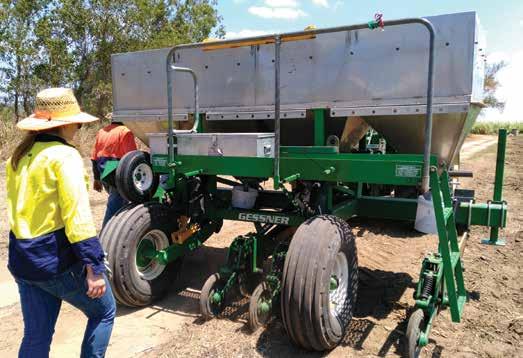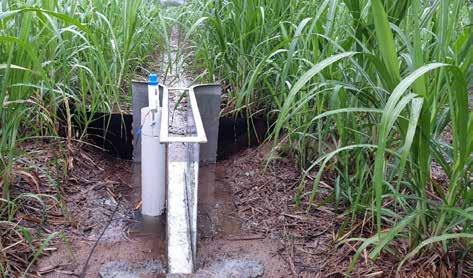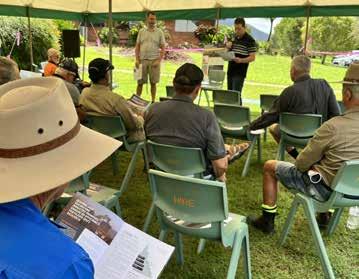
3 minute read
EEFs MAINTAIN PRODUCTIVITY AND PROFITABILITY AND PROVIDE ENVIRONMENTAL BENEFITS
Doug Hardwick’s family has been farming cane in the Mulgrave district since 1948. He has been an active participant in Sugar Research Australia (SRA) trials for many years.
Doug provided his farm and time most recently to research trials conducted as part of the ‘Support of cane farmer trials of enhanced efficiency fertiliser (EEF) in the catchments of the Great Barrier Reef (EEF60)’ project; and then its extension ‘Cane farmer trials and modelling of EEFs’ funded by the partnership between the Australian Government’s Reef Trust and the Great Barrier Reef Foundation.
Advertisement
Enhanced efficiency fertilisers (EEFs) have been designed to control the release of nitrogen fertilisers. They (there is more than one type) have been proposed as a tool sugarcane growers might consider to increase nitrogen use efficiency on their farms, while providing water quality benefits. With support from project partners, including growers like Doug, EEFs were tested over four seasons on 74 sugarcane farms located between Mossman and Bundaberg.
The results from extensive field trials were evaluated by SRA and economists from the Department of Agriculture and Fisheries (DAF) in regions across the catchments of the Great Barrier Reef. The results show that when high nitrogen loss conditions are likely, EEFs are a good option.
Doug supports these findings but is the first to admit that there are growers who find it hard to change established farming practices and might need more encouragement to trial EEFs.
SRA Agronomist Julian Connellan and DAF Economist Matthew Thompson have been part of the project since its inception in 2017.
“We are pleased that we have been able to provide industry with simple guidelines which can be adopted by growers to improve their nitrogen use efficiency while maintaining productivity and profitability,” Julian said.
CSIRO recently released modelling which provided more evidence to support the findings of the extensive field research. The investigation looked at climate, soil and crop start interactions across the Wet Tropics.
The Agricultural Production Systems sIMulator (APSIM) farming systems model was used to investigate when and where
EEF use could reduce nitrogen losses to the environment. It indicated that the risk of nitrogen losses was mostly associated with late season fertiliser application in drier regions and mid-late season fertiliser application in very wet regions of the Wet Tropics.
Both field trials and modelling showed EEFs were more effective when high loss conditions were experienced, particularly late in the season.
Doug encourages other canegrowers to consider trying EEFs.
“Old habits die hard in all industries. But I believe there are other ways, and must be new ways, of doing things,” he said.
“With the high price of fertiliser, the last thing we want to do is waste what we put on our crop, and if we’re able to reduce what we use in the first place, then all the better,” he said.
“I was curious about enhanced efficiency fertilisers, keen to see if there would be any benefits, and I believe in the right conditions, there are.
“The takeaway for me, is that by using EEFs on late ratoons, late in the growing season and at the start of the wet season, up here in the Wet Tropics, I will be able to grow the same amount of cane with 20 per cent less fertiliser. That means, I’ll come out on top.


“This has been an intensive, worthwhile project. The agronomic and economic research has been precise, and I fully support the recommendations that have come from it,” Doug said.
For growers interested in utilising EEFs, consider the following recommendations:
• For DMPP and blended CRF products (20% CRF 80% Urea), using an N rate 20% below the SIX EASY STEPS ® recommendation has been shown to maintain productivity and profitability.
• Limit use of CRF blends with a higher proportion of CRF (greater than 20%) as this results in lower grower profitability due to higher fertiliser costs.
• Use EEF products when high N loss conditions are expected, particularly late season fertiliser application. In very wet regions, growers could target mid-late fertiliser application times.
• Use of EEFs at the lower N rate is generally applicable to most growing conditions and with experience growers could expand their use. However, application of EEFs early in the season is less likely to provide benefit as N losses are not as likely.
• Take advantage of the improved cost-competitiveness of the new nitrogen inhibitor, 3,4-dimethylpyrazole phosphate (DMPP), and blended controlled release fertiliser (CRF) products (applied at 20% less N) when urea prices are higher than average.
• It is recommended that any change in management is tested on-farm. This will build confidence in both the new nutrient rates/products but will also aid the process of fine - tuning a nutrient management program as part of STEPS 5 and 6 in SIX EASY STEPS ®
The results and recommendations from the EEF60 project and additional modelling have now been added to the SIX EASY STEPS ® Toolbox and can be found on the SRA website by scanning the QR code below.
Scan to view the EEF60 Project web page.
The on-ground testing and modelling of the effectiveness of enhanced efficiency fertilisers in the Wet Tropics catchments of the Great Barrier Reef project was funded by the partnership between the Australian Government’s Reef Trust and the Great Barrier Reef Foundation with support from a collaborative partnership between Sugar Research Australia, Department of Agriculture and Fisheries, CSIRO, CANEGROWERS, productivity services and cane farmers.










